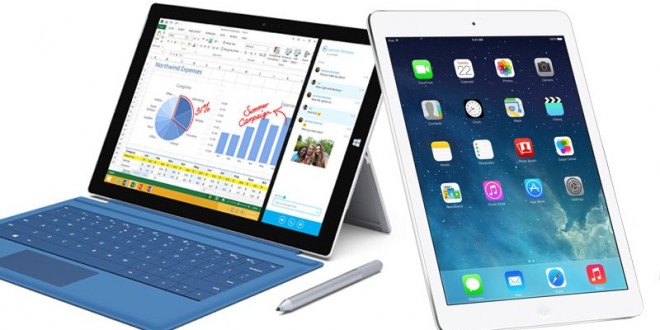Surface Pro 4 has less features than the iPad Pro.
What is amazing about the Apple iPad Pro is that, from a hardware standpoint, it is basically a netbook once you add the keyboard. The Microsoft Surface Pro, on the other hand, is essentially a convertible Windows tablet.
IPAD PRO VS SURFACE PRO
It had been rumoured for more than a year, but no-one expected Apple to announce an iPad Pro at an iPhone launch event (much less that Microsoft would also appear on stage). But it’s real and its closest competitor is Microsoft’s Surface Pro. Both tablets run Office and both have physical keyboards, but which should you buy? Here’s our iPad Pro vs Surface Pro comparison.
It would be easier to compare the new iPad with the Surface Pro 3, but the Surface Pro 4 is about to launch in a few weeks, so we’ll make comparisons with both of them. Bear in mind that we’re going by rumours about the Surface Pro 4 as no specs have been confirmed at this time. Microsoft is keeping tight-lipped until the 6 October launch. We will, of course, update this article when the Surface Pro 4 is official.
IPAD PRO VS SURFACE PRO: SOFTWARE
Let’s deal with this first as it’s the most controversial aspect. Some people will prefer Windows while others will like iOS 9. There are pros and cons of running a desktop OS on a tablet, which means there’s no obvious ‘winner’ in that sense.
Having full-blown Windows on the Surface Pro means you can do anything you can do on a desktop PC. You can attach USB peripherals, including a mouse or a hard drive, and you can connect a second monitor. This will make it a better laptop replacement than the iPad Pro in some peoples’ eyes.
But if you view them as tablets first (and if you will mainly use them as a tablet) the iPad would be the obvious choice. It runs an operating system that’s dedicated to a mobile device and therefore has no impossibly small buttons and controls that are designed to be used with a keyboard and mouse. It’s fingers (and thumbs) all the way.
Or almost all the way, because there’s the new Apple Pencil. Which we’ll get to a bit later.
Fortunately the Surface Pro isn’t stuck with Windows 8. Windows 10 improves the experience of switching between laptop and tablet modes (Microsoft calls this Continuum) and should also improve the selection of tablet-style apps available in the store.
But, oh, this is a sore point for the Surface Pro because while developers will be cursing Apple for introducing yet another screen size and resolution for the iPad Pro, existing apps designed for other iPads will scale and run on the new version. And the huge selection puts Microsoft’s paltry collection firmly in the shade.
In Windows’ favour, though, is the vast catalogue of desktop software which will run happily on a Surface Pro. iPad owners might have a smug look now that Office and Adobe apps have come to their tablets, but Surface Pro users can install the full versions of Photoshop, AutoCAD and everything else.
As we said, there are pros and cons.
IPAD PRO VS SURFACE PRO: SCREEN AND STYLUS
The Surface Pro 2 had a puny 10.6in screen that was simply too small for most people. Even the upgrade to 12in with the Pro 3 wasn’t quite enough: the iPad Pro at 12.9in is about right in our opinion.
It has a resolution of 2732×2048 compared to 2048×1536 of previous iPads. Pixel density remains the same at 264ppi.
The Surface Pro 3 has a resolution of 2160×1440, which is 216ppi on a 12in screen. The difference in sharpness is negligible. No-one is sure what size screen the putative Surface Pro 4 will have; rumours suggest 14in, but it could be anything from 12- to 14in. Resolution is another unknown, particularly as Microsoft could change the aspect ratio and go for something closer to iPad proportions.
The existing Surface Pro 3 has an IPS touchscreen and an active capacitive stylus, using N-trig technology. It’s capable of detecting 256 levels of pressure (more than enough), plus the angle at which you’re holding the pen. It’s great for sketching and drawing. The Surface Pen also has three buttons, one of which launches OneNote even if the Surface is asleep.
Apple’s Pencil is also active and has in-built sensors and a battery. It’s an optional extra unlike the bundled Surface Pen, and can also detect force and tilt angle. As we haven’t yet had a chance to test it for ourselves, we can’t say which is best, but it’s sure to be a close call. Both have very low latency and are about as close to ‘real’ drawing as you can get with a digital screen.
IPAD PRO VS SURFACE PRO: SPECIFICATIONS
Here are the key specs for the iPad Pro
iOS 9
Apple A9X 64-bit processor
4GB RAM
Up to 128GB storage
12.9in Retina display (2732×2048, 264ppi, 4:3) multitouch display
Lightning port
802.11a/b/g/n/ac Wi-Fi, dual-channel
Bluetooth 4.2
8Mp iSight camera, 1.2Mp FaceTime camera
Four speakers with auto orientation
Optional Apple Pencil
Battery life up to 10 hours (web browsing)
305x220x6.9mm
713g (723g cellular model)
And here are the Surface Pro 3’s vital stats:
Windows 8.1 Pro (free upgrade to Windows 10 Pro)
Intel Haswell Core i3/i5/i7 processor
Up to 8GB DDR3 RAM
Up to 512GB SSD
12in ClearType full-HD (2160×1440, 216ppi, 3:2) multitouch display
USB 3.0 port
802.11a/b/g/n/ac Wi-Fi
Bluetooth 4.0
Mini DisplayPort
2x 5Mp cameras (front and rear)
Stereo speakers with Dolby sound
Surface Pen
Battery life up to nine hours (web browsing)
292×201.3×9.1mm
800g
Agencies/Canadajournal
 Canada Journal – News of the World Articles and videos to bring you the biggest Canadian news stories from across the country every day
Canada Journal – News of the World Articles and videos to bring you the biggest Canadian news stories from across the country every day



